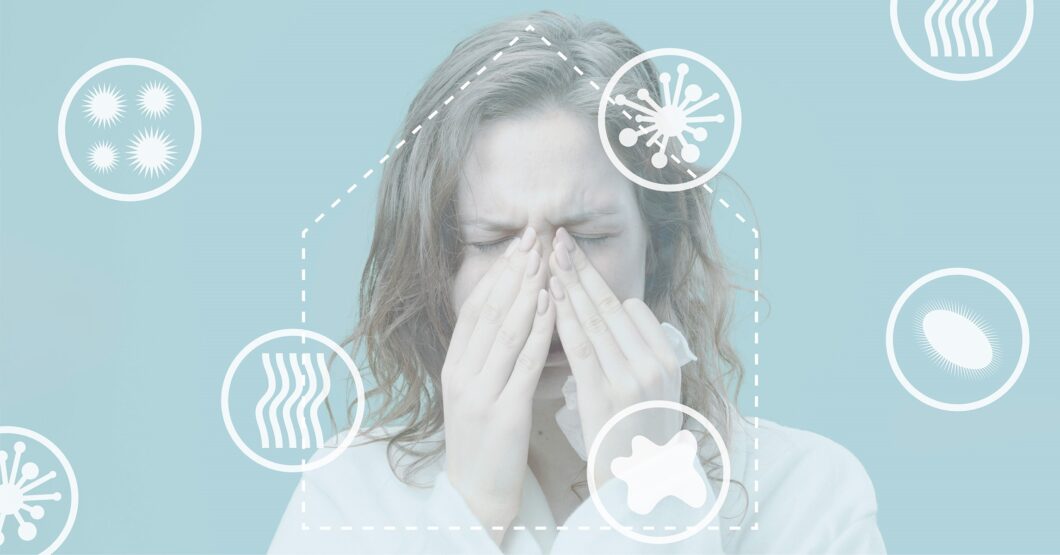When hearing about respiratory allergies, most people think of pollen, but it’s important to know that pollen isn’t the only allergen causing problems.
Also due to the high level of pollution, especially in big cities, every year more and more people develop allergies to dust, mould or pet hair.
What you will find in this article
The most frequent symptoms of respiratory allergies
Respiratory allergies are not always immediately identified, sometimes they are mistaken for chronic rhinitis or colds, because the most frequent symptoms are itchy eyes, runny nose, sneezing.
It is the immune system, in fact, that is activated, just like in a cold, but, in this case, the triggering causes are not viruses or bacteria but an allergen in the air (aeroallergen) such as suspended dust, spores or pollen.
The immune system, in fact, treats allergens as a foreign substance, and in response it reacts producing large quantities of immunoglobulin E (IgE). This reaction, combined with the release of chemicals such as histamine, can cause inflammation.
And continuously show some symptoms such as:
- Coughing
- Sneezing
- Runny nose
- Persistent tearing
- Dark circles under the eyes (due to increased blood flow near the sinuses.)
- Allergic conjunctivitis (swollen red membranes lining the eyes with crusty lids)
- Persistent rubbing of the nose, especially in children
What are the causes of allergy in your home
In allergy sufferers, as we have seen, the body has an immune response to even the most common things found in the air. And since we spend a significant part of our day inside our homes, it is vital for allergy sufferers to examine the air inside the home and identify what may unknowingly be causing chronic problems.
Animals
In the case of animals, the sources can be multiple: dust and pollen from outside can be deposited in the fur of dogs and cats, to this are added some allergenic substances present for example in the salivary glands or in the urine.
Mould
Have you ever noticed the mould on the shower towel or in some parts of the house? It seems to stop there, firmly attached to the wall or fabric, but it isn’t. The fungal spores emitted by mould love to “travel” and are very easily dispersed in the air. We all inhale the air containing these particles, but with some people, they cause allergies or asthma symptoms. The most common moulds that cause allergies are Cladosporium and Aspergillus.
Insects and dust mites
Dust mites are a common source of allergens. They are microscopic insects that thrive in humid, warm areas such as furniture, rugs, and bedding.
A dust mite allergy can cause allergic rhinitis (runny nose), asthma symptoms, or flare-ups of dermatitis and eczema.
Formaldehyde and Volatile Organic Compounds (VOCs)
Formaldehyde is widely used in construction and household products, such as glues, air fresheners, floor polishes, carpet backings, dyes, liquid cleaners, markers, paints and toilet cleaners, printer emissions. While very high levels of formaldehyde exposure cause physical reactions in everyone, some people have allergic reactions even in small doses.
Common symptoms include burning eyes and throat, rash, chest tightness, fatigue, and headache.
Pollen
In early spring, when the trees and herbaceous plants are pollinating, the air fills with these tiny suspended particles, which disperse and which through the windows, animal hair and our clothes can enter the house and accumulate here, creating discomfort and problems for those suffering from allergies and asthma.
How to prevent and relieve symptoms of respiratory allergies
You can reduce your exposure and limit the presence of allergens in the home to ease and reduce the discomfort and symptoms related to allergic reactions:
- Avoid carpeting, fabric-covered furniture and heavy fabric curtains – they can harbor dust and dust mites. It is always best to have surfaces that you can clean easily and daily.
- Do not hang the laundry outside: pollen can settle on sheets and towels.
- Clean Often: Use a dry cloth on hard surfaces to remove dust at least once a week.
- Humidity: Keep the relative humidity in your home below 50% to minimize the growth of dust mites.
- Heating: do not bring the heating above 20 degrees (here we explain better which temperature to keep in the house)
- Bed linen: Wash all bedding once or twice a week in hot water (without fabric softener and with natural detergents) to kill dust mites. Wrap mattress and pillows in mite-proof covers.
- Free the air in your home from pollutants: Jonix Cube constantly cleans the air of the rooms you live in, purifying it and reducing allergens, to make you breathe deeply in complete tranquility.

